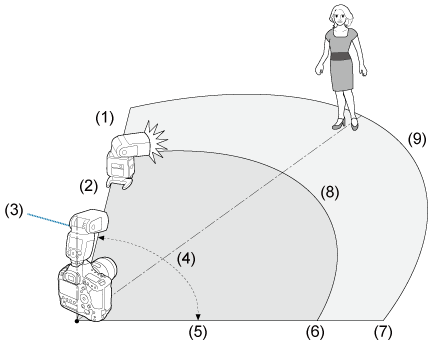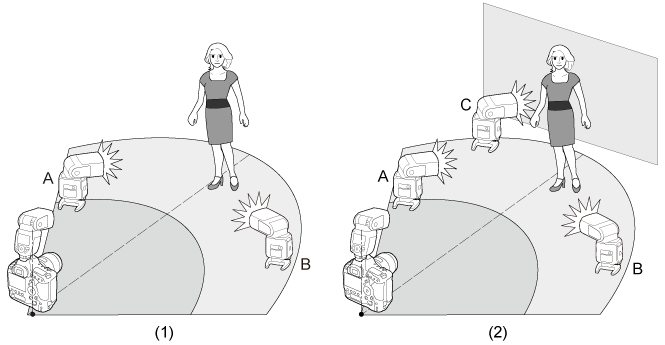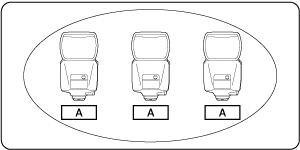Optical Transmission Wireless Flash Shooting
Using a Canon Speedlite (receiver) with an optical transmission wireless shooting function, you can easily perform wireless multiple flash shooting in the same way as normal E-TTL II / E-TTL autoflash strobe photography.
The system is designed so that the settings of the EL-1 (sender unit) are automatically applied to the EL-1 (receiver unit) controlled wirelessly. Therefore, you do not need to operate the receiver unit during shooting.
Positioning and Operation Range
-
Automatic Flash Photography with 1 Flash Receiver ()

(1) Indoors
(2) Outdoors
(3)
(4) About 80°
(5) Transmission range
(6) About 8 m / 26.2 ft.
(7) About 12 m / 39.4 ft.
(8) About 10 m / 32.8 ft.
(9) About 15 m / 49.2 ft.
-
Automatic Flash Photography with Receivers divided into Groups (, )
You can divide the receiver units into two or three groups and perform E-TTL II / E-TTL autoflash shooting while changing the flash ratio (flash output rate).

(1) 2 (A, B) groups
(2) 3 (A, B, C) groups
Caution
Note
- Using the mini stand provided with the receiver unit, position the receiver of the receiver unit towards the sender unit.
- When shooting indoors, the transmission may be reflected off the wall, which may cause the camera to be activated even when the layout is still preliminary.
Group Control
Firing group A

If you need more flash output or wish to perform more sophisticated lighting, you can increase the number of receiver units. Simply set an additional receiver unit to the firing group (A, B, or C) whose flash output you want to increase. There is no restriction on the number of units.
For example, if you set a firing group with three receiver units to , the three units are treated and controlled as a single firing group A with a large flash output.
Caution
- To fire the 3 firing groups A, B and C together, select
. With the
setting, firing group C does not fire.
- If you shoot with firing group C pointing directly toward the main subject, overexposure may result.
- With certain EOS film cameras that support E-TTL autoflash, you cannot perform wireless multiple flash shooting with a flash ratio setting.
Note
- The flash ratio of 8:1 to 1:1 to 1:8 is equivalent to 3:1 to 1:1 to 1:3 (1/2-stop increments) when converted to the number of stops.